|
| |
| January
2006 |
| SBG
Split Twenty
years on |
Part
2 |
| In 1985, the
Scottish Bus Group (SBG) comprised of seven companies. Nothing much
had changed for years, but with the twin impending threats of
de-regulation and privatisation looming, now seemed the time for a
shake-up. The plan was simple, but not foolproof - create
smaller, leaner companies ready for the brave new world. Three
of the larger companies would basically be split in two - Strathtay being
born from Northern, Clydeside coming out of Western, and Lowland being the
Borders area of Eastern. The final company was Kelvin - a
mish-mash of bits of Midland, Central and Eastern around
Glasgow. How did it work out ? Did they survive
? Read on to find out the answers .. |
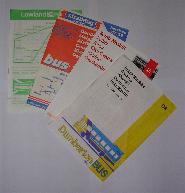 |
| |
| Kelvin |
How
did it start ?
Kelvin put the hotch into potch. Consisting of SBG depots on
the north side of Glasgow, it fought a bitter battle with Greater
Glasgow PTE, only
for it to end up under the common banner of First Glasgow, its successor.
As a prelude to the new companies, in mid-1985 Eastern's Baillieston depot
closed a vehicles transferred to Midland ownership. When Kelvin was created,
Baillieston's former stock was joined by Cumbernauld, Kilsyth, Kirkintilloch, Milngavie
and Stepps from Midland and Old Kilpatrick from Central. The
ragamuffin company was designed to compete the PTE. |
What
happened next ?
Kelvin was radical. It threw away its crown jewels by selling
off its newest Leopards and replacing them with Nationals (upper left) from other SBG
companies such as Highland and Northern. It soon adopted a
dynamic new blue/yellow stripey livery (bottom left to right). It re-cast its routes
at de-regulation buying new minibuses (middle) and second hand Routemasters to run
the services. The only full-size vehicles bought new were
Metrobuses for Cumbernauld (upper right). |
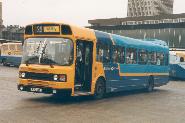 |
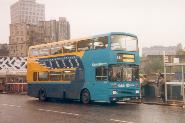 |
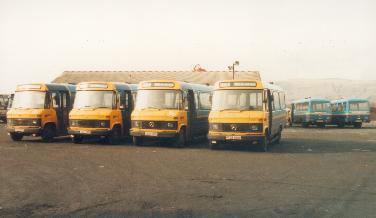 |
| Liveries |
 |
Where did it
go wrong ?
Two words - Central SMT. For many years Central had been a
hotbed of industrial relations problems. These culminated in a
series of disastrous strikes in 1990 which left the company badly
compromised with impending privatisation. There was a quick
and obvious solution - amalgamate Kelvin and Central and re-name them
Kelvin-Central Buses (right). It was an an unhappy time
with independents
sensing blood moving in on all sides. |
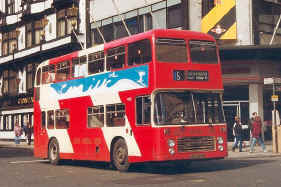 |
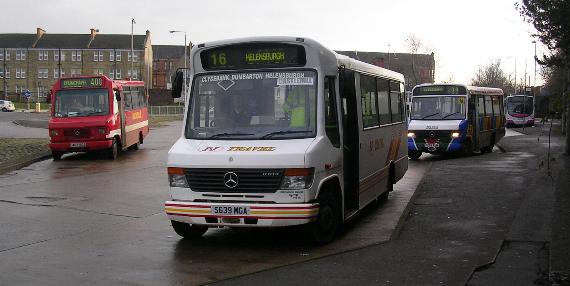 |
Where are they now ?
Kelvin Central changed their name again and again, they bought second hand
vehicles by the bucket load (above right) and were offered to their management for a
nominal sum when privatisation came around. After buying
several competitors, KCB (as they were by then called) had begun to steady
the boat when Strathclyde's Buses, the former PTE company, bought
them. They in turn joined the First fold in the late
1990's. Today First Glasgow still operates as two separate
units - the old PTE and KCB, but in reality to the public they are
indistinguishable. The only Kelvin depot left is Cumbernauld,
and only a handful of routes remain recognisable from 20 years
ago. Competition still rages in Lanarkshire and Dumbartonshire
(above).
KCB RIP. |
| Kelvin |
| |
| Click to enlarge photos. |
| |
| Photo
Facts (top to bottom) |
 | Kelvin 1247 (MSO18W), an
ex-Northern Leyland National, leaving Buchanan Bus Station in Glasgow
for Stirling in September 1986. |
 | Kelvin 2679 (D679MHS), a
dual-purpose Metrobus in Cathedral St. Glasgow, heading for
Cumbernauld. These were the only full-size new vehicles
that Kelvin bought, and some have just recently come out of service. |
 | Kelvin minibuses at Kirkintilloch
depot in March 1987. Kelvin flooded the east end of
Glasgow, particularly Sprinburn, with these vehicles on short-lived
high-frequency services. Being robust buses, they went on
to serve with other operators, Western in particular. |
 | Kelvin T147 (B258TYS), an
Alexander TE-bodied Tiger, at Balloch bus stance in September
1985. The first livery was a rather drab two-tone blue,
that was later livened up by the application of a yellow
front. This batch of vehicles was originally ordered by
Central, but delivered to Kelvin. Rather perversely, before the
split no vehicles were re-positioned, so Kelvin inherited lots of
odd-men-out. These buses were re-united with the rest of
the batch when KCB was formed. Kelvin's first fleet
numbering scheme was a simplified version of Midland's, using only the
last letter of each vehicle class (T for Tiger, E for Leopard
etc). However they soon adopted a more revolutionary four
digit sequence, which is remarkably similar to the five digit one used
by Stagecoach today. |
 | Kelvin O1 (ULS96X), an ECW
bodied Olympian in Buchanan Bus Station in September 1985, sporting
the then new stripey blue/yellow livery. This vehicle was
originally with Eastern Scottish, and passed briefly to Midland when
Baillieston garage closed and the vehicles moved to Stepps.
It is operating route 100 from Drumchapel to Garthamlock, a connection
of two routes that used to terminate in the city centre.
This service was a result of ScotMAP, which once again prepared the
SBG companies for de-regulation. |
 | Kelvin 2047 (EMS359V), an
Alexander T-type Leopard, outside Buchanan Bus Station in June
1987. After de-regulation in 1986, Kelvin moved almost all
their services to Anderston X bus station, and only called outside
Buchanan Bus Station. This Leopard is wearing the final
simplified version of the blue/yellow livery. |
 | Kelvin Central Buses (KCB) 1787
(LEU255P), a Bristol VRT that started life with Bristol Omnibus,
in Argyll St. Glasgow in April 1993. KCB bought Dominators
from Merseyside and Atlanteans from Hull amongst other oddities. |
 | Clydebank bus station in December
2005. Avondale, PJ Travel and McColl are all competing
with First (just visible at the back on the right) in former Kelvin
territory in Dunbartonshire. |
|
| |
| Links |
|
|
| |
| |
| Clydeside |
How
did it start ?
Clydeside's is perhaps the saddest tale of all. It lost not
one, but two of its former operating areas. It fought bitter
battles with Strathclyde PTE and independent operators along the
way. Now it's been subsumed into the Arriva, a distant outpost
of the aquamarine empire.
|
| As with Kelvin, Clydeside in its original
guise only lasted for three years - from 1985 to 1988. Formed
from the Glasgow area depots of Western (Greenock, Inchinnan, Johnstone,
Paisley, Thornliebank, Rothesay and Largs), it too was designed to head of
competition from Strathclyde PTE. It adopted a vibrant red and
yellow livery. |
| Clydeside
purchased 70 London Routemasters
and introduced several cross-river routes (lower right) as it went head-to-head with the
PTE. Another innovation was the Quicksilver branding (above
right), applied
to vehicles running local express services to such places as Paisley and
Kilmacolm. It only bought a handful of new vehicles and soon
eliminated the erstwhile Seddon Pennine (above left).
It was attacked relentlessly in Paisley by the PTE as
expected. Meantime independent
operators continued to niggle away in Greenock with up to 12 companies
competing at any one time. |
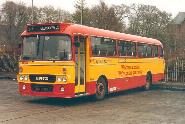 |
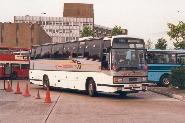 |
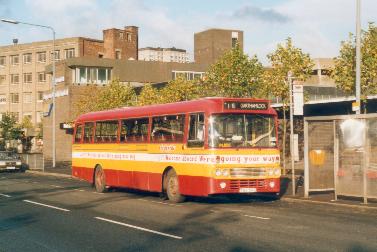 |
What
happened next ?
The impending privatisation of the Scottish Bus Group companies saw
Western assume control of Clydeside again in November 1988.
Clydeside was a true chameleon, having control of different depots under
every re-incarnation. Initially Rothesay (right) was somewhat
surprisingly under their remit, however after 1988 ownership returned to Western along with Largs and equally surprisingly
Greenock. |
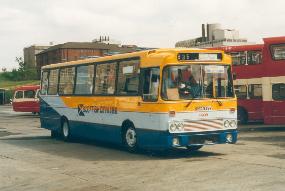 |
This left the Glasgow area depots to function with
Clydeside names but Western livery. Western almost immediately
disposed of the Routemasters replacing them with Fleetlines and National
1's from Kelvin. Apart from these changes nothing much else
changed until Clydeside was sold to a employee/management buyout with the
assistance of Luton & District in October 1991.
|
| Fleetlines |
|
|
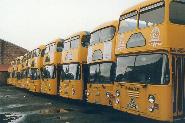 |
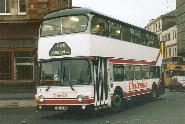 |
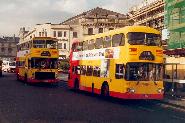 |
| When
Clydeside was merged back with Western in 1989, they bought redundant
Fleetlines from Kelvin-Central (above left) to help replace
Routemasters. The vehicles operating in the Glasgow area wore
Western livery but carried Clydeside names (above middle).
When Clydeside went its own way again in 1991 they inherited most of these
Fleetlines and repainted them in the revised red/yellow livery (above
right). |
| |
Where did it
go wrong ?
Clydeside 2000 as it was then known, consisted of depots at Greenock
(returned to the fold), Inchinnan, Johnstone, Paisley, Thornliebank and
Largs (also reunited). Tough times lay ahead with Paisley
shutting in August 1992, and Thornliebank following soon
after. A bright new version of the red/yellow livery (below
right) could not
disguise the problems and after |
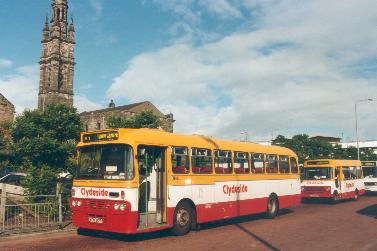 |
| withdrawing from Glasgow routes, operated
for more than half a century, almost the entire double-deck fleet was sold
in November 1993. Elderly second hand stock in the shape of
ex-Kelvin and Lancaster Leopards (above) were bought as well as more minibuses to
counter the relentless competition in Greenock. Luton &
District ownership passed to British Bus in 1994, and subsequently to
Arriva in 1997. |
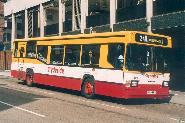 |
| Eventually Arriva was forced to accept defeat
and in 2002 abandonned Greenock operation, with McGill (no relation to the
former Paisley company) assuming control of many of the former routes.
Arriva today is a pale shadow
of the original Clydeside company, with |
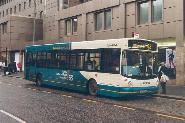 |
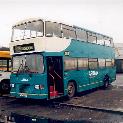 |
| more than 90% of its operation
concentrated on Paisley (above left). Only three other routes
survive. The fleet is now mainly based on Metroriders and
Darts, with only a handful of double-deckers (above right). The chameleon is now a
mere tadpole. |
| |
| Click to enlarge photos. |
| |
| Photo
Facts (top to bottom) |
 | Clydeside 844 (KSJ944P), an
Alexander bodied Seddon, at Kilmarnock bus station in June
1985. The Seddons were not long for this world under
Clydeside ownership. |
 | Clydeside P401 (B401OSB), a
Plaxton bodied Dennis Dorchester, slaloming through Buchanan bus
station in June 1987. This is one of the few vehicles that
Clydeside bought new. |
 | Western PL655 (TSJ55S), a
traditional Y-Type Leopard in Clydeside livery, outside Buchanan Bus
Station in Glasgow in December 1989. It is on the
cross-river (16) service from South Nitshill to Garthamlock. |
 | Clydeside R939 (DSD939V), an
Alexander T-type Seddon, arriving in Buchanan Bus Station in July
1986. This vehicle was one of three that were hastily
converted to Citylink status for the Glasgow to Campbelltown
service. It is seen here operating for Rothesay depot on
their summer only express service (835) to Edinburgh. This
may have been the only and only time that a Rothesay vehicle operated
a through service from the island of Bute to the mainland. |
 | Withdrawn Kelvin-Central Fleetlines at
Kirkintilloch depot in September 1989. |
 | Western JR374 (LMS154W), a
former Kirkintilloch based Fleetline, operating for Johnstone depot in
Glasgow in December 1989. |
 | Clydeside 850 (LMS170W), being
pursued by Volvo Ailsa 890 (KSD90W) in Paisley in December
1993. |
 | Clydeside 777 (WCW312R), a
Y-Type Leopard formerly with Lancaster, in Greenock in September 1996. |
 | Clydeside 509 (M109RMS), an
East Lancs bodied Scania, a British Bus inspired purchase in Glasgow
in May 1995. This vehicle still operates for Arriva
Scotland today. |
 | Arriva S860OGB, an Alexander
bodied Dart, fresh in service in Paisley in December 1998. |
 | Arriva 1885 (H670GPF), an East
Lancs bodied Volvo Citybus at Inchinnan depot in December 1998, one of
a small batch bought from Arriva
London South that year. These vehicles
comprise the only double-deckers in the fleet. |
|
| |
 |
| |
| Thanks are due to the Western
Enthusiasts Club bi-monthly news sheets in the preparation of the
Clydeside article. |
| |
| Links |
|
|
|